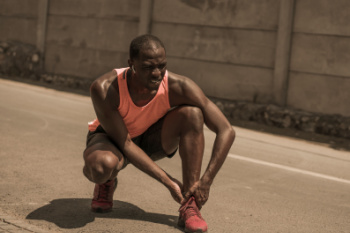Items filtered by date: March 2025
Heel Pain Can Be Treated!
Managing an Ingrown Toenail

An ingrown toenail occurs when the edge of a toenail grows into the surrounding skin, leading to pain, redness, and swelling. This often affects the big toe and may result from improper nail trimming, wearing tight footwear, or toe injuries. People with naturally curved nails are more likely to experience ingrown toenails. If left untreated, an ingrown toenail can worsen, potentially leading to an infection that increases pain and interferes with daily activities. A podiatrist can assess the severity of the ingrown toenail and determine the most effective treatment. In some cases, the podiatrist may trim the ingrown portion of the nail, while more severe cases may require surgery to remove part of the nail and prevent regrowth in that area. Wearing shoes that fit properly and trimming toenails straight across can help reduce the risk of recurrence. If you have developed an ingrown toenail that shows signs of infection, it is suggested that you schedule an immediate appointment with a podiatrist for an exam, diagnosis, and treatment options.
Ingrown toenails may initially present themselves as a minor discomfort, but they may progress into an infection in the skin without proper treatment. For more information about ingrown toenails, contact George Tellam, DPM of Ankle & Foot Associates. Our doctor can provide the care you need to keep you pain-free and on your feet.
Ingrown Toenails
Ingrown toenails are caused when the corner or side of a toenail grows into the soft flesh surrounding it. They often result in redness, swelling, pain, and in some cases, infection. This condition typically affects the big toe and may recur if it is not treated properly.
Causes
- Improper toenail trimming
- Genetics
- Improper shoe fitting
- Injury from pedicures or nail picking
- Abnormal gait
- Poor hygiene
You are more likely to develop an ingrown toenail if you are obese, have diabetes, arthritis, or have any fungal infection in your nails. Additionally, people who have foot or toe deformities are at a higher risk of developing an ingrown toenail.
Symptoms
Some symptoms of ingrown toenails are redness, swelling, and pain. In rare cases, there may be a yellowish drainage coming from the nail.
Treatment
Ignoring an ingrown toenail can have serious complications. Infections of the nail border can progress to a deeper soft-tissue infection, which can then turn into a bone infection. You should always speak with your podiatrist if you suspect you have an ingrown toenail, especially if you have diabetes or poor circulation.
If you have any questions, please feel free to contact our offices located in Orange Park and Jacksonville Beach, FL . We offer the newest diagnostic and treatment technologies for all your foot care needs.
How to Tell if You Have a Sprained Ankle

Ankle sprains occur when the ligaments that support the joint stretch or tear due to sudden twisting or rolling of the foot. This can result in pain, swelling, bruising, and difficulty bearing weight. The severity of the injury varies, with mild ankle sprains involving slight ligament damage, while severe sprains cause significant instability. Without proper care, a sprained ankle may lead to long-term weakness or repeated injuries. A podiatrist can assess the extent of the ankle sprain through a thorough examination, and may recommend immobilization, supportive bracing, or in severe cases, surgery to restore stability. Persistent swelling, severe pain, or difficulty walking should prompt an immediate evaluation. People with a history of ankle injuries or underlying conditions that affect circulation or nerve function should seek professional care to prevent further complications. Proper recovery includes restoring strength and stability to reduce the risk of future sprains. If you suspect you have sprained an ankle, it is suggested that you make an immediate appointment with a podiatrist for an exam, diagnosis, and treatment.
Although ankle sprains are common, they aren’t always minor injuries. If you need your ankle injury looked at, contact George Tellam, DPM from Ankle & Foot Associates. Our doctor can provide the care you need to keep you pain-free and on your feet.
How Does an Ankle Sprain Occur?
Ankle sprains are the result of a tear in the ligaments within the ankle. These injuries may happen when you make a rapid shifting movement while your foot is planted. A less common way to sprain your ankle is when your ankle rolls inward while your foot turns outward.
What Are the Symptoms?
- Pain at the sight of the tear
- Bruising/Swelling
- Ankle area is tender to touch
- In severe cases, may hear/feel something tear
- Skin discoloration
Preventing a Sprain
- Wearing appropriate shoes for the occasion
- Stretching before exercises and sports
- Knowing your limits
Treatment of a Sprain
In many cases, the RICE method (Rest, Ice, Compression, and Elevate) is used to treat ankle sprains. However, you should see a podiatrist to see which treatment option would work best with your injury. In severe cases, surgery may be required.
It is important to ask your doctor about rehab options after you receive treatment for your injury. Stretching, strength training, and balance exercises may help the ankle heal while also preventing further injury.
If you have any questions, please feel free to contact our offices located in Orange Park and Jacksonville Beach, FL . We offer the newest diagnostic and treatment technologies for all your foot care needs.
Symptoms and Treatment of Fungal Toenails

Fungal nail infections primarily affect toenails, causing them to thicken, become discolored, and occasionally separate from the nail bed. In mild cases, fungal toenail infections might not require immediate treatment, yet some patients have a higher risk of complications and should seek professional advice promptly. Risk factors include diabetes, psoriasis, peripheral arterial disease, smoking, or medications that weaken the immune system. Fungal infections typically develop from minor injuries near the nail. They can be spread by sharing personal items like nail clippers or towels, walking barefoot in moist public areas, or transferring athlete’s foot from the skin between toes to the toenails. Treatment is often challenging due to frequent recurrences, and may include prescription antifungal nail lacquers, or oral antifungal medications prescribed by a podiatrist. In severe cases, a podiatrist may recommend surgery to remove the affected nail completely. If you notice that your toenail appears infected, it is suggested that you schedule an appointment with a podiatrist for an exam, diagnosis, and treatment options.
If left untreated, toenail fungus may spread to other toenails, skin, or even fingernails. If you suspect you have toenail fungus it is important to seek treatment right away. For more information about treatment, contact George Tellam, DPM of Ankle & Foot Associates. Our doctor can provide the care you need to keep you pain-free and on your feet.
Symptoms
- Warped or oddly shaped nails
- Yellowish nails
- Loose/separated nail
- Buildup of bits and pieces of nail fragments under the nail
- Brittle, broken, thickened nail
Treatment
If self-care strategies and over-the-counter medications does not help your fungus, your podiatrist may give you a prescription drug instead. Even if you find relief from your toenail fungus symptoms, you may experience a repeat infection in the future.
Prevention
In order to prevent getting toenail fungus in the future, you should always make sure to wash your feet with soap and water. After washing, it is important to dry your feet thoroughly especially in between the toes. When trimming your toenails, be sure to trim straight across instead of in a rounded shape. It is crucial not to cover up discolored nails with nail polish because that will prevent your nail from being able to “breathe”.
In some cases, surgical procedure may be needed to remove the toenail fungus. Consult with your podiatrist about the best treatment options for your case of toenail fungus.
If you have any questions, please feel free to contact our offices located in Orange Park and Jacksonville Beach, FL . We offer the newest diagnostic and treatment technologies for all your foot care needs.
What Are Diabetic Blisters?

Diabetic blisters are a common yet often overlooked complication of diabetes. These blisters typically appear on the feet and legs and are filled with clear fluid. They can be painless at first but may become sore or irritated if left untreated. Diabetic blisters are more likely to form due to poor circulation and nerve damage caused by high blood sugar levels, which makes the skin more fragile and susceptible to injury. While these blisters often heal on their own, they can become infected if not properly cared for. A podiatrist can help by properly cleaning and dressing the blister to reduce the risk of infection. This type of doctor may also advise on keeping the area protected and suggest ways to prevent further blisters. Additionally, a podiatrist may recommend custom footwear, or orthotics to reduce friction and pressure on the feet. If you have diabetes and have developed blisters, it is suggested that you are under the care of a podiatrist who can help you to manage this serious condition.
Blisters may appear as a single bubble or in a cluster. They can cause a lot of pain and may be filled with pus, blood, or watery serum. If your feet are hurting, contact George Tellam, DPM of Ankle & Foot Associates. Our doctor can provide the care you need to keep you pain-free and on your feet.
Foot Blisters
Foot blisters are often the result of friction. This happens due to the constant rubbing from shoes, which can lead to pain.
What Are Foot Blisters?
A foot blister is a small fluid-filled pocket that forms on the upper-most layer of the skin. Blisters are filled with clear fluid and can lead to blood drainage or pus if the area becomes infected.
Symptoms
(Blister symptoms may vary depending on what is causing them)
- Bubble of skin filled with fluid
- Redness
- Moderate to severe pain
- Itching
Prevention & Treatment
In order to prevent blisters, you should be sure to wear comfortable shoes with socks that cushion your feet and absorb sweat. Breaking a blister open may increase your chances of developing an infection. However, if your blister breaks, you should wash the area with soap and water immediately and then apply a bandage to the affected area. If your blisters cause severe pain it is important that you call your podiatrist right away.
If you have any questions, please feel free to contact our offices located in Orange Park and Jacksonville Beach, FL . We offer the newest diagnostic and treatment technologies for all your foot care needs.

